Key takeaways
- NaNoWriMo encourages a supportive writing community, transforming the solitary nature of writing into a collective journey.
- Participating in writing challenges helps students build confidence, embrace imperfection, and develop consistent writing habits.
- Integrating flexible goals and celebrating milestones fosters motivation and encourages student ownership of their writing process.
- Resources that align writing with activism enhance engagement and empower students to explore important social issues through their narratives.
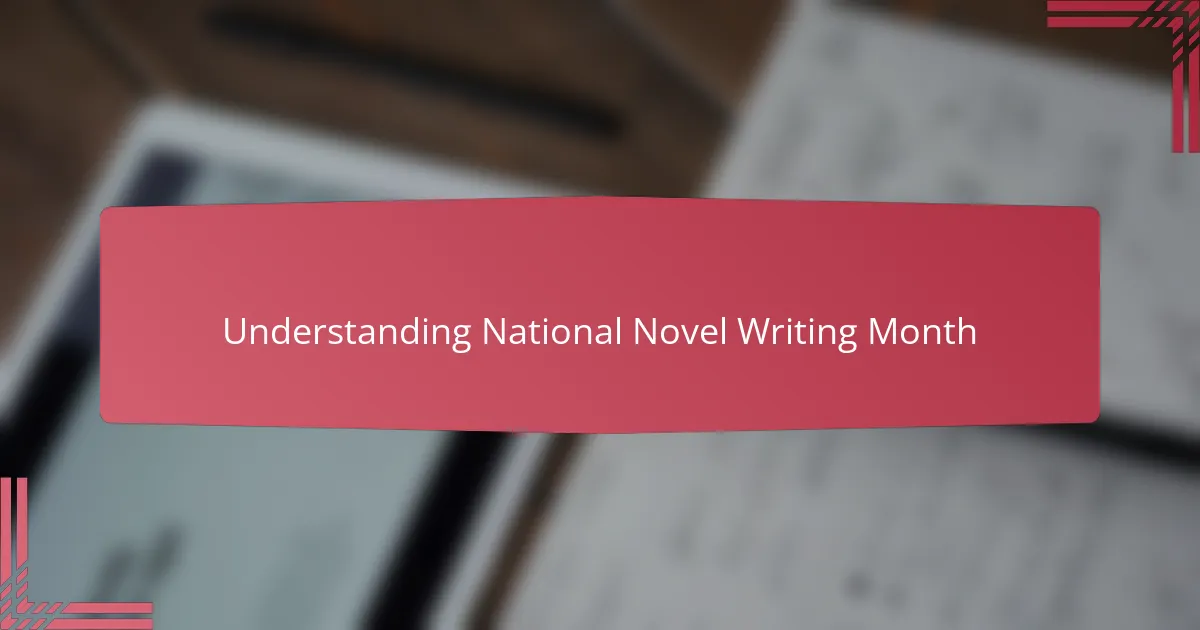
Understanding National Novel Writing Month
National Novel Writing Month, or NaNoWriMo, is a creative challenge that invites writers to draft a 50,000-word novel during the month of November. I remember my first NaNoWriMo experience; the daily writing goal felt daunting, yet there was something liberating about giving myself permission to write without judgment. Have you ever wondered how this pressure-cooker format can inspire such a diverse community of writers?
What strikes me most about NaNoWriMo is how it transforms an often solitary process into a collective journey. The enthusiasm and encouragement shared online and in local groups create an environment where writers feel supported, even when the words don’t come easily. It’s fascinating to see how this structure pushes people beyond their comfort zones and sparks unexpected creativity.
NaNoWriMo isn’t just about reaching a word count; it’s about cultivating discipline, embracing imperfection, and experiencing the joy of storytelling. This event resonates deeply with me because it honors effort over polish, encouraging writers to trust their voices first. Could this be the key to making writing feel less intimidating and more accessible?
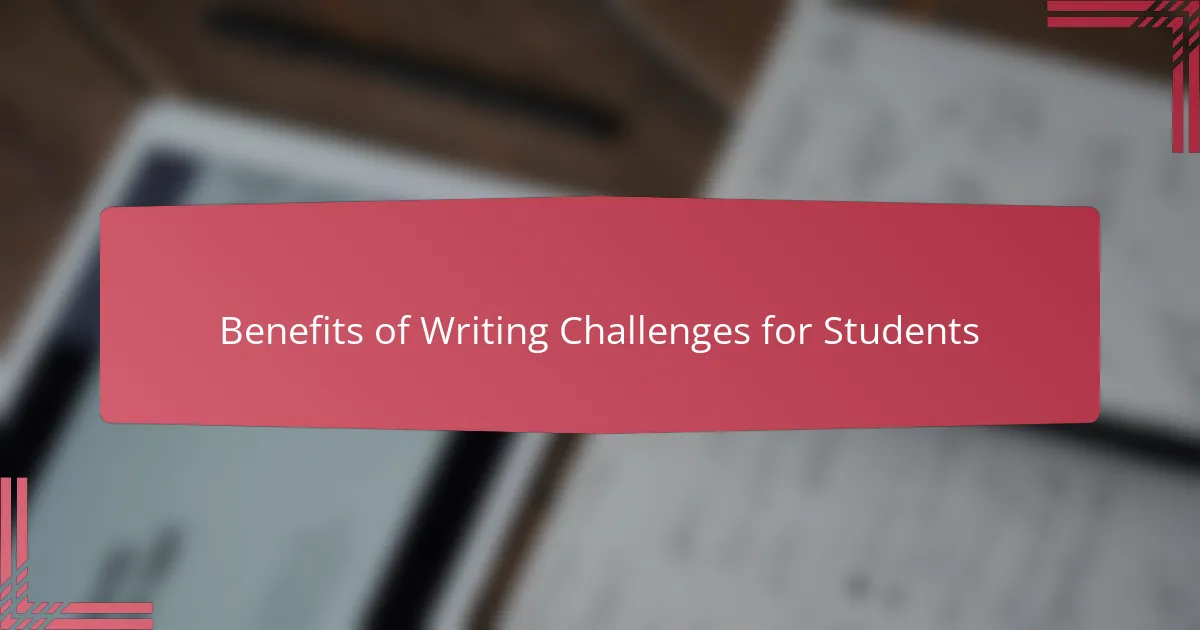
Benefits of Writing Challenges for Students
Writing challenges like NaNoWriMo offer students a unique chance to build writing stamina. When I encouraged my students to participate, I saw how meeting daily word goals helped them develop a steady writing habit that carried beyond the challenge. Have you noticed how consistent practice often boosts confidence in unexpected ways?
Beyond just improving skills, these challenges create a safe space for students to embrace imperfection. I remember one student who was terrified of making mistakes finally letting go and just writing freely during NaNoWriMo—her creativity soared once she stopped self-editing in real time. Doesn’t that freedom to experiment seem like a vital part of learning?
Perhaps the most powerful benefit I’ve witnessed is the sense of accomplishment that comes with completing a giant task. When students realize they can write tens of thousands of words in a month, their view of themselves as writers shifts dramatically. Isn’t it encouraging to see how a structured challenge can unlock hidden potential?
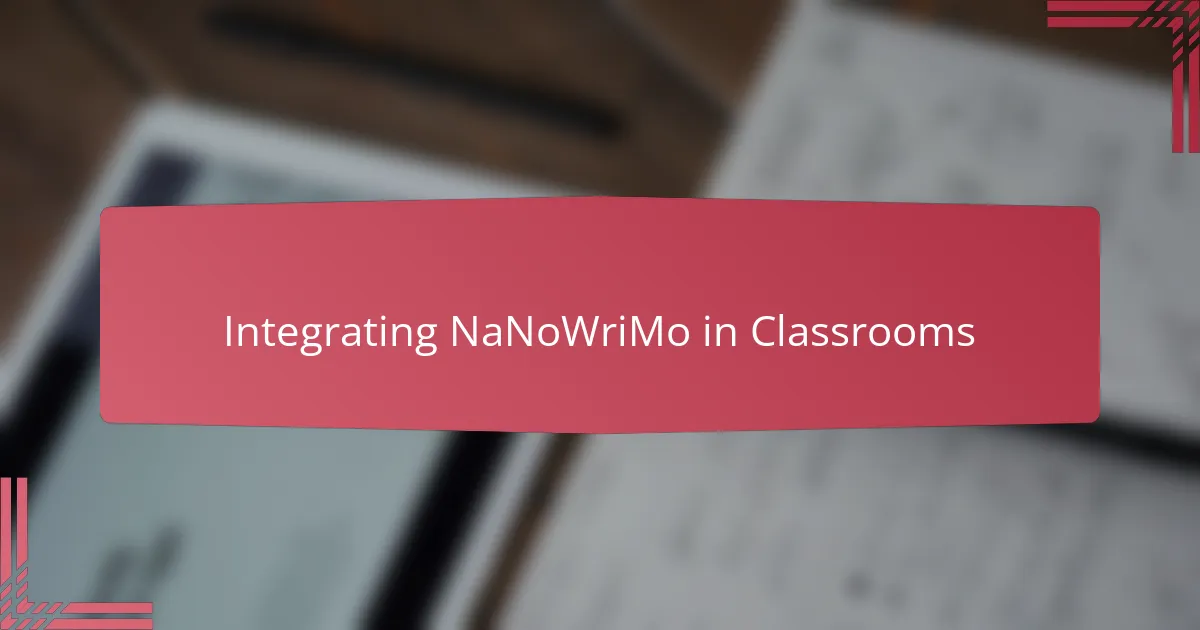
Integrating NaNoWriMo in Classrooms
When I first brought NaNoWriMo into my classroom, I was curious how students would respond to the pressure of a daily word count. Surprisingly, many found that having a clear, time-bound goal helped them focus and write more freely than usual. Have you ever noticed how deadlines, when framed as challenges rather than punishments, can motivate creativity?
I also integrated mini check-ins where students shared their progress and frustrations. This simple practice built a sense of community, much like the broader NaNoWriMo culture I admire. Seeing students encourage each other transformed my classroom into a supportive writing cohort, and I realized that this peer energy often does wonders for reluctant writers.
One approach I found effective was allowing flexibility in genre and topic, so each student could write something truly meaningful to them. I saw shy voices become bold as stories took shape without fear of judgment. Isn’t it powerful how giving students ownership can ignite their passion for writing?
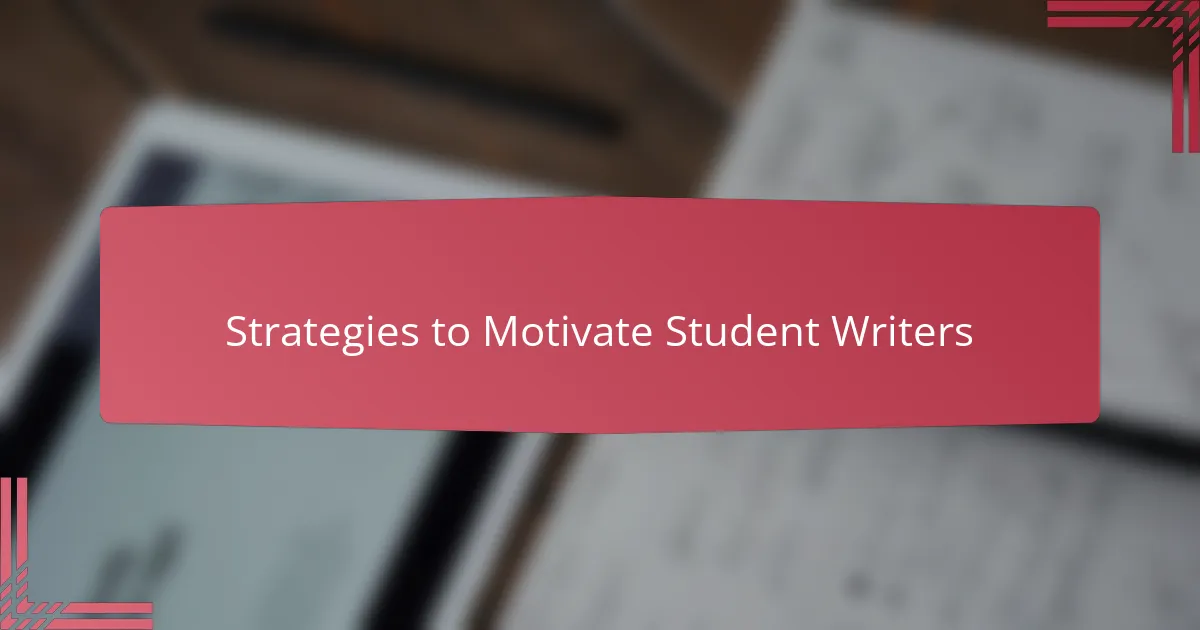
Strategies to Motivate Student Writers
One strategy I found invaluable was setting small, achievable daily goals. When students focus on hitting those bite-sized targets instead of fixating on the entire novel, writing feels less overwhelming. Doesn’t breaking down a huge task into manageable steps often make it seem more doable?
I also noticed how celebrating every milestone—even just completing a paragraph—keeps motivation alive. Praising effort rather than perfection helps students see progress as a journey, not a race. Have you ever seen how positive reinforcement can transform a hesitant writer into a confident storyteller?
Creating a community around writing proved essential too. When students share their struggles and triumphs, they feel less isolated and more driven. From my experience, this peer support mirrors the vibrant encouragement at NaNoWriMo and makes a huge difference in keeping writers engaged.
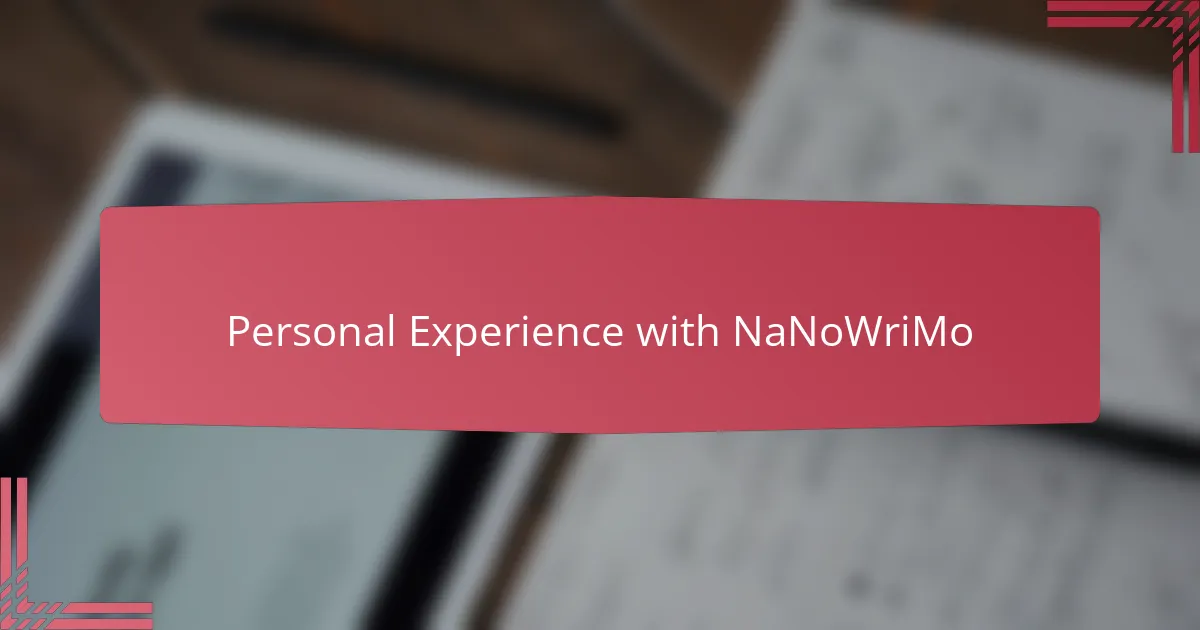
Personal Experience with NaNoWriMo
NaNoWriMo challenged me in ways I hadn’t anticipated—there were moments when I doubted I could hit the daily word count, but pushing through that doubt turned into a deeply rewarding experience. Have you ever felt that mix of frustration and exhilaration when you surprise yourself by simply showing up to write every day? That’s exactly what kept me going.
One particular memory stands out: halfway through the month, I hit a wall where the words just dried up. Instead of giving up, I reached out to the NaNoWriMo community online and found an outpouring of support. It was like discovering a tribe of fellow writers who understood the struggle and cheered me on, which reminded me how vital encouragement can be in the creative process.
Looking back, NaNoWriMo wasn’t just about finishing a novel—it was about learning to silence my inner critic and embrace the messy, imperfect first draft. Doesn’t that feeling of permission to write badly first really shift your relationship with writing? For me, it sparked a newfound confidence that I still carry into my teaching and writing today.
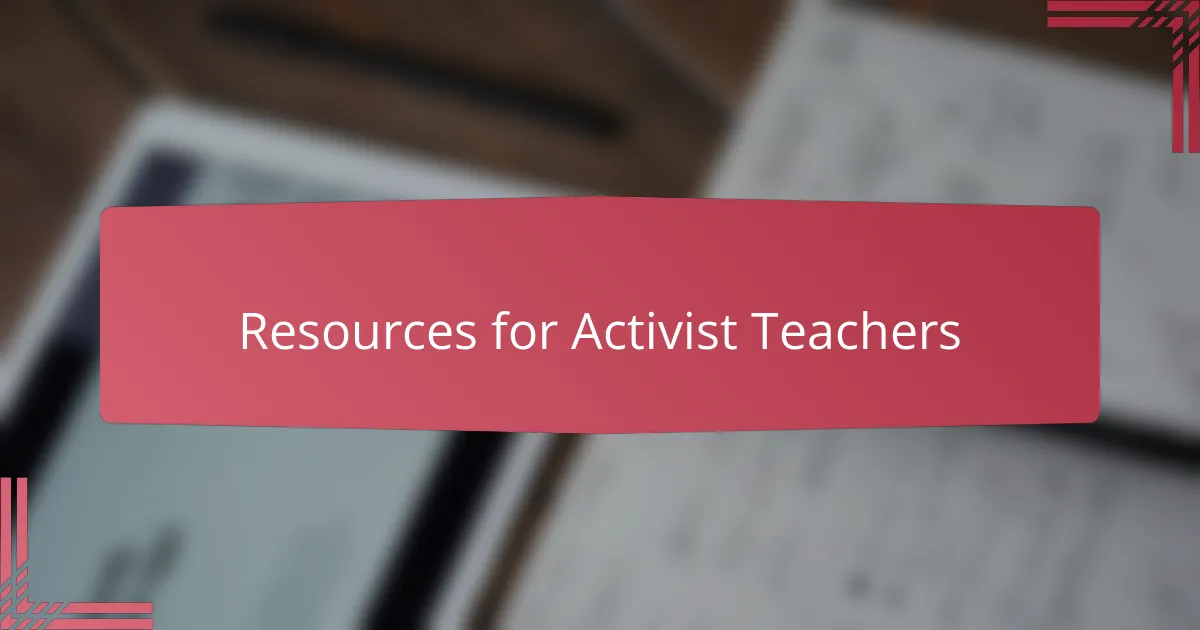
Resources for Activist Teachers
When I first searched for resources tailored to activist teachers, I quickly realized how valuable it is to have materials that align with our mission of fostering critical thinking and social justice through writing. Finding guides that integrate NaNoWriMo with themes of activism helped me frame writing not just as a skill, but as a powerful tool for change. Have you noticed how resources with a clear activist lens can energize both teaching and student engagement?
I’ve also found that connecting with online educator communities dedicated to activist teaching provides a treasure trove of lesson plans, prompts, and discussion ideas that highlight voices often left out of mainstream narratives. These resources didn’t just add content to my curriculum; they opened doors for students to explore their identities and social issues more deeply. Isn’t it incredible how the right materials can transform a writing challenge into a platform for empathy and activism?
Finally, I can’t stress enough the importance of adaptable tech tools and writing apps recommended in these resources. They make participation in NaNoWriMo accessible for students of all backgrounds and abilities, which is a key aspect of inclusive teaching. Have you tried integrating digital tools that support diverse learners? In my experience, these aids can make the difference between frustration and full creative expression.